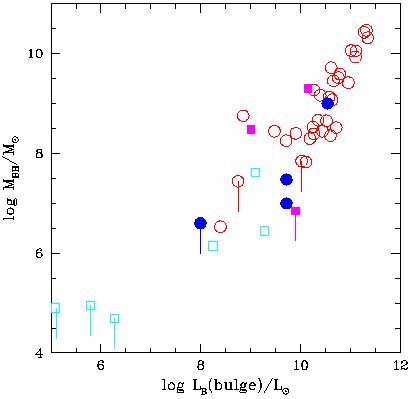


A direct estimate of the contribution of quasars to the EBL
depends on the poorly known bolometric correction and the possible
existence of a distant population of dusty AGNs with
strong intrinsic absorption, as invoked in many models for the X-ray
background. These Type II QSOs, while undetected at
optical wavelengths, could contribute significantly to the far-IR background.
It is in principle possible to bypass some of the above uncertainties by
weighing the local mass density of black holes remnants
[29].
Recent dynamical evidence indicates that supermassive black holes reside
at the center of most nearby galaxies. The available data (see
Fig. 3)
show a correlation (but with a large scatter) between bulge and black
hole mass, with MBH
 0.006 Msph
as a best-fit
[23].
The mass density in old spheroidal populations today is estimated to be
0.006 Msph
as a best-fit
[23].
The mass density in old spheroidal populations today is estimated to be
 sph h =
0.0018+0.0012-0.00085
[16], implying a
mean mass density of quasar remnants today
sph h =
0.0018+0.0012-0.00085
[16], implying a
mean mass density of quasar remnants today
Since the observed energy density from all quasars is equal to the
emitted energy divided by the average quasar redshift, the
total contribution to the EBL from accretion onto black holes is
(h = 0.5), where
Figure 3. Black hole mass distribution
against the bulge luminosity of their host galaxies
[23].
Arrows indicate upper limits on
MBH. The symbols denote different galaxy types: empty
circles (E),
filled squares (S0), filled circles (Sab), and empty
squares (Sbc-Scd).


 0.05 is the efficiency of accreted mass to radiation
conversion (in units of 5%). Therefore, unless dust-obscured accretion onto
supermassive black holes is a very efficient process
(
0.05 is the efficiency of accreted mass to radiation
conversion (in units of 5%). Therefore, unless dust-obscured accretion onto
supermassive black holes is a very efficient process
( >> 0.05),
a population of quasars peaking at z ~ 1.5-2 is expected to make a
contribution to the brightness of the night sky not exceeding 10-20%
[14],
[21].
>> 0.05),
a population of quasars peaking at z ~ 1.5-2 is expected to make a
contribution to the brightness of the night sky not exceeding 10-20%
[14],
[21].
